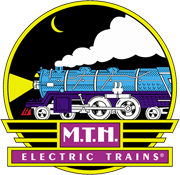Available Items

Between 1830 and the 1950s, hundreds of steam locomotive designs were created, each seeking to be bigger, better, faster, or more powerful than those before. In 1900, a New York Central mechanic named Frederick Whyte developed the modern system for classifying steam locomotives. In the Whyte system, locomotives are designated by wheel arrangements, with the number of wheels on the lead truck, drive wheels, and trailing truck wheels separated by hyphens. Engines with the same wheel arrangements also shared many running characteristics and were assigned similar jobs. Most arrangements also received nicknames reflecting the first appearance of the designs.
For example, a 4-6-2 has four wheels behind the cowcatcher, six drivers, and two wheels under the firebox. An early (1902) order of 4-6-2s was made for the Missouri Pacific railroad, and the type became known as the モPacific.ヤ Pacifics were smooth-riding at high speed and pulled most passenger trains until the 1930s. Other wheel arrangements and nicknames are shown in the table on this page.
Steam Engines
Wheels Whyte system Nickname
OO 0-4-0 Four wheel switcher
OOO 0-6-0 Six wheel switcher
OOOO 0-8-0 Eight wheel switcher
oOOO 2-6-0 Mogul
oOOOo 2-6-2 Prairie
oOOOO 2-8-0 Consolidation
oOOOOo 2-8-2 Mikado
oOOOOoo 2-8-4 Berkshire
oOOOOO 2-10-0 Decapod
oOOOOOo 2-10-2 Santa Fe
oOOOOOoo 2-10-4 Texas
ooOO 4-4-0 American
ooOOo 4-4-2 Atlantic
ooOOO 4-6-0 Ten Wheeler
ooOOOo 4-6-2 Pacific
ooOOOoo 4-6-4 Hudson
ooOOOO 4-8-0 Twelve Wheeler
ooOOOOo 4-8-2 Mountain or Mohawk
ooOOOOoo 4-8-4 Northern
ooOOOOO 4-10-0 Mastodon
ooOOOOOOo 4-12-2 Union Pacific
oOOO OOOooo 2-6-6-6 Allegheny
oOOOO OOOOoo 2-8-8-4 Yellowstone
ooOOO OOOoo 4-6-6-4 Challenger
ooOOOO OOOOoo 4-8-8-4 Big Boy
Other steam engines fall outside of the Whyte system. There were several patented designs for geared locomotives. These engines used cylinders mounted vertically or diagonally on the side of the boiler to spin a drive shaft that delivered power to the wheels through a series of gears, much like an automobile transmission. These engines could not go fast, but they were much more powerful for their size than regular steamers and were used by logging railroads to pull heavy loads up steep hills.
Near the end of the steam era, several railroads experimented with turbine engines, where steam spun a rotor inside the locomotive rather than pushing rods. Some turbines powered wheels directly through gearing, others spun a generator feeding electric motors by the wheels. None of the turbines was successful enough to prevent diesels from replacing steam engines during the 1950s. However, M.T.H. Electric Trains makes steam engines of all types, with full sound and smoke effects, so that you can relive the power and glory of steam on your own layout!






